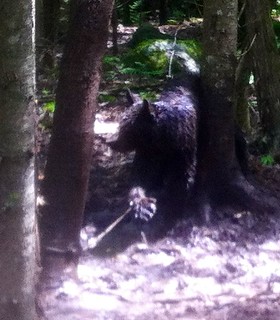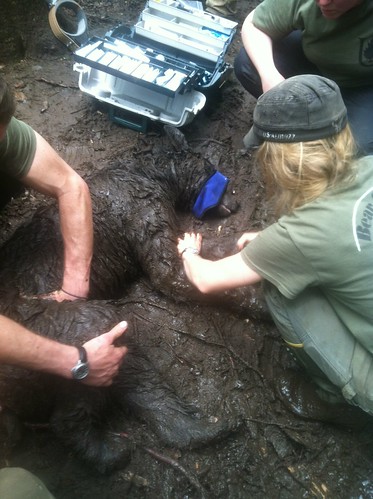The 12-member study team begins the day at headquarters - a classroom inside the college's science building. A large wall map shows the growing number of sites in the woods where bear traps have been set.
At around noon, Lisa Bates, an experienced trapper and co-leader of the project, gets a call. "Yeah. Oh yeah, definitely. Congratulations on your capture," she says.
A three-person group, checking trap sites, has come upon a young black bear about 15 minutes away, in Burnham. "It could be a yearling. But, like, a two-year-old female is not much bigger than a yearling," Bates says. "All right, well those are all good observations. Good job. We'll see you there. Bye."
Maine has as many as 30,000 black bears. It's one of the largest populations in the contiguous United States, says George Matula, an associate professor of Wildlife Biology at Unity, and the study's other co-director.
"The state does an outstanding job of moitoring the population and knowing where it's at," he says. "They know that there's areas of the state that aren't adaquately represented by what they're collecting. And so they gave us permission to do this."
A century ago or more, most of Waldo County was farmland. But as the forests have returned so have the bears. In the woods now, the team hauls equipment to a clearing near the trap site. Ally Pesano, a Unity junior, was part of the group that first spotted the bear.
"It's covered in mud. And it's really wet. There's a bog over there," she says.
Lisa Bates goes in alone to assess the situation and heads back out to the team. "So, that's a bear," she says, between 80 and 100 pounds, Bates guesses, as she shows the students how to put together the right drug cocktail to anesthetize the animal. "If I have 200 milligrams of Ketamine, I'm going to have 100 milligrams of Xylazine."
 Bates, Ally Pesano and the two other students head into the bog with a syringe, attached to the end of a long pole. The bear, a cable wrapped tightly around its right front paw, eyes the team warily from the muddy water. He's removed as much bark as possible from the one tree within his grasp. Standing just out of reach, a student shuffles his feet to distract the bear, as Bates delivers the injection. Bates, Ally Pesano and the two other students head into the bog with a syringe, attached to the end of a long pole. The bear, a cable wrapped tightly around its right front paw, eyes the team warily from the muddy water. He's removed as much bark as possible from the one tree within his grasp. Standing just out of reach, a student shuffles his feet to distract the bear, as Bates delivers the injection.
We head back out, wait 10 minutes, grab the rest of the gear and return. The bear is fast asleep. An initial exam, by Bates, yields the day's best piece of news. "That, my friends, is a female!"
She's three or four years old, hasn't had any cubs yet and weighs about 100 pounds. "Females are the ones we really want," Matula says, "because they're the ones we want to collar and be able to follow to the den, and get those data that we can get at the den."
George Matula says studying the females and their offspring will help determine whether the movement patterns, home ranges and denning activity of bears in central Maine are different from those of bears in other parts of the state.
Students take hair samples, draw blood and monitor the bear's breathing and vital signs. Unity College Junior Jonah Gula takes her temperature: 97.3.
Bates draws a small tattoo on the inside of the bear's lip. A student tags an ear. And the team attaches a small radio collar aroud her neck. After about the 40 minutes the bear starts to twitch, so Jonah Gula and the rest of the team wrap up their work and head out to debrief.
"It was exciting to put the collar on," Gula says "I, like, worked in refurbishing the old VHF collars. That was my favorite part."
"I was nervous when the bear was still moving around, but once we got her down, you just gotta stay calm," Ally Pesano says. "We have to get things done so people stay safe and bear stays safe."
The project, Unity Junior Ally Pesano is quick to add, is a team effort. Students are doing everything from negotiating with landowners to deploy new traps to developing new systems to process all the specimens and other data they bring back from the field.
It's a unique project. So far, Unity officials say they haven't been able to find another like it - designed specifically for undergraduates - in the country.
Photos: Jay Field
|














No comments:
Post a Comment